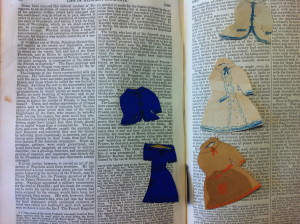"...some hand, now forever quiet, had made at certain passages strong pen and ink marks, long since browned by time." -- George Eliot, The Mill on the Floss (1860)
Book Traces is a crowd-sourced web project aimed at identifying unique copies of nineteenth- and early twentieth-century books on library shelves. Our focus is on customizations made by original owners in personal copies, primarily in the form of marginalia and inserts.
Sponsored by NINES at the University of Virginia and led by Andrew Stauffer, Book Traces is meant to engage the question of the future of the print record in the wake of wide-scale digitization. The issue is particularly urgent for the materials from the long nineteenth century. In most cases, pre-1800 books have been moved to special collections, and post-1923 materials remain in copyright and thus on the shelves for circulation. But college and university libraries are now increasingly reconfiguring access to public-domain texts via repositories such as Google Books. We see a prevalent assumption in library policy circles that copies of any given nineteenth-century edition are identical. As a result, we are now anticipating the withdrawal of large portions of nineteenth-century print collections in favor of digital surrogates.
We believe that, as libraries begin to manage down their print holdings, special attention should be paid to these historical materials, which in many cases came to university libraries from alumni donors and bear marks of use by their original nineteenth-century owners. These books thus constitute a massive, distributed archive of the history of reading, hidden in plain sight in the circulating collections. Marginalia, inscriptions, photos, original manuscripts, letters, drawings, and many other unique pieces of historical data can be found in individual copies, many of them associated with the history of the institution that collected the books in the first place. These unique attributes cannot be located by any electronic catalog. Each book has to be open and examined.
That's where you come in. Thousands of such books -- marked or otherwise customized by nineteenth-century owners – are on library shelves. Via Book Traces, NINES hopes to help devise a triage process for discovering them, cataloguing them more fully, and making better-informed decisions about print collections management. Further, we hope to model this process as part of a national effort for coordinating the management of nineteenth-century printed materials in college and university libraries.
Please consider integrating Book Traces into your Victorian courses this fall: get the students into the library stacks and get their hands on nineteenth-century books. Visit http://booktraces.org today!
